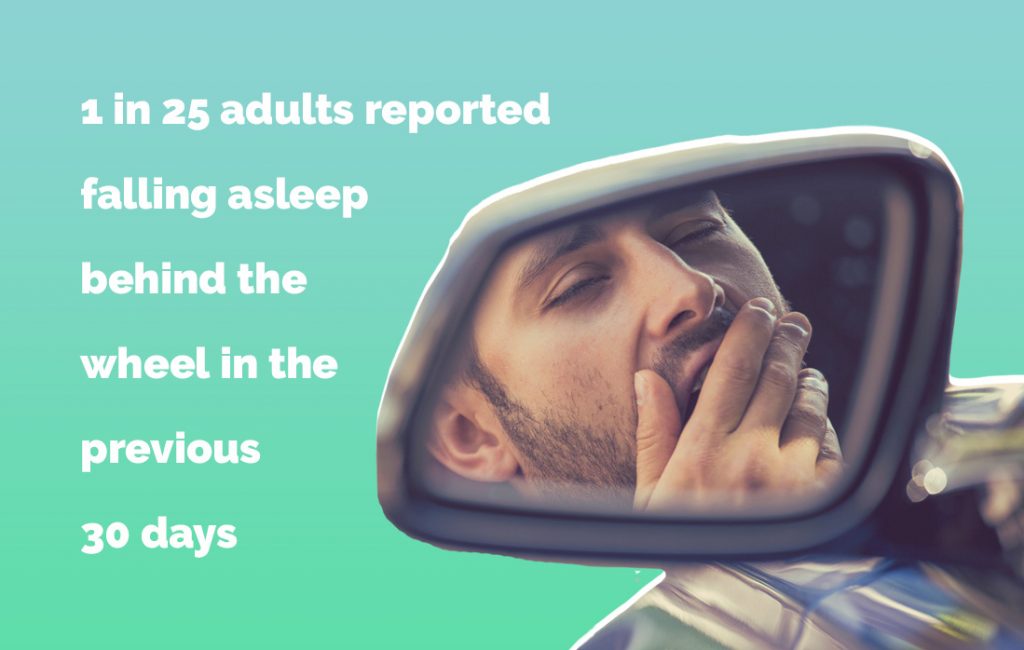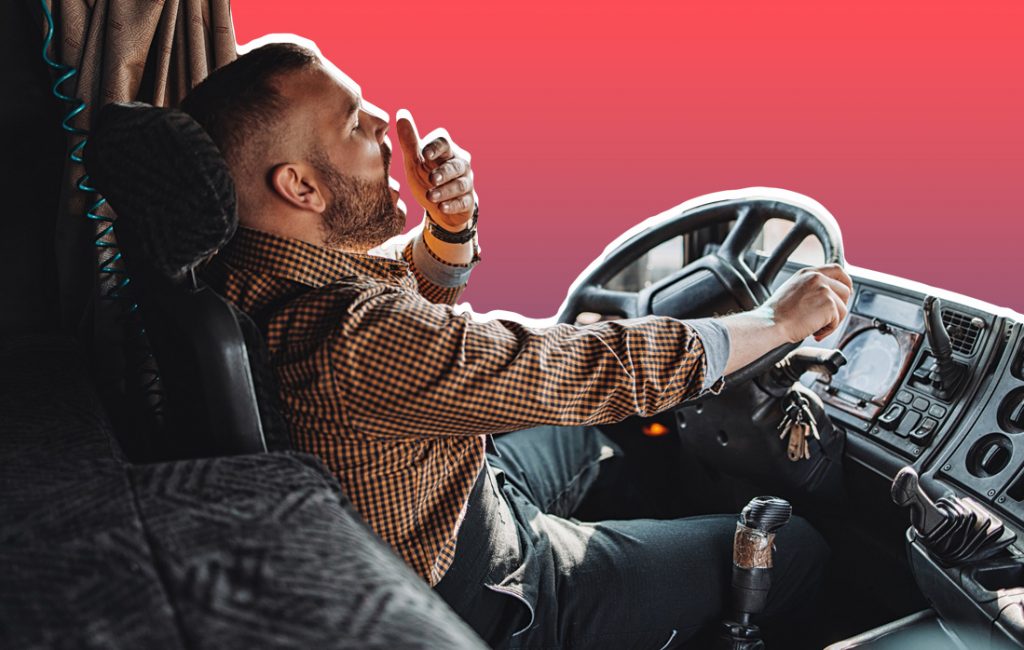We’ve all had moments during a long road trip where we want nothing more than to arrive at our destination, stretch our legs and climb into bed as quickly as possible. While that’s perfectly normal, the trouble comes when that urge to get some shuteye becomes more urgent, manifesting itself as drowsy—and dangerous—driving.
What is drowsy driving?
Drowsy driving is a dangerous combination of driving while sleepy or fatigued, which creates impairment levels that can mimic driving under the influence of alcohol. Drowsy driving can happen for a variety of reasons, but most often it happens due to:
- Drivers who are sleep deprived
- Untreated or undiagnosed sleep disorders
- Shift work that disrupts someone’s regular circadian rhythm
- The aftereffects of medications or alcohol
And though you might think it’s uncommon and unlikely to happen to you, that isn’t the case—an estimated 1 in 25 adult drivers reported falling asleep behind the wheel in the previous 30 days.

Drowsy Driving Statistics
Though most of us spend more time in a car than any other vehicle—and therefore feel the most safe in cars—motor vehicles are actually one of the most dangerous forms of transportation around.
- According to AAA, drowsy driving contributes to around 9 percent of all crashes.
- In 2017, drowsy driving accounted for about 100,000 crashes, 71,000 injuries, and 150 deaths, according to the National Safety Council (NSC). To put that into perspective, the MetLife Stadium—the NFL’s largest stadium—can seat 82,500 people per game, nearly 20,000 less than the number of crashes caused by drowsy driving each year.
- Most accidents happen between midnight and 6am, when drivers are typically sleepy.
- New Jersey and Arkansas are the only 2 states with laws that address drowsy driving
- Maggie’s Law (New Jersey): If a driver hasn’t slept in 24 hours and causes a fatal car accident, they can be charged with vehicular homicide
- Arkansas: A driver can be charged with negligent homicide if they haven’t slept in 24 hours and causes a fatal crash.
Sleep Disorders
We already know sleep disorders can have a significant impact on sleep quality, and it’s unsurprising that low-quality sleep — or not getting enough overall — can bleed into daytime functioning. Here’s what the data shows:
- A 2018 study found that severe sleep apnea was correlated with a 123 percent increased risk of auto accident compared to those without sleep apnea.
- Researchers also found that those sleeping 6 hours each night had a 33 percent greater risk of a crash than those sleeping 7 to 8 hours.
- One analysis of nearly 2500 drivers found that those with sleep apnea and insomnia are 29 percent and 33 percent more likely to be involved in a crash or near crash; plus, drivers with sleep disorders were found to be 29 percent more likely to be inattentive on the road.
Who is most likely to drive drowsy?
A variety of factors, including someone’s lifestyle and profession, may contribute to their likelihood of drowsy driving. Top indicators include:
- Age. Drivers between the ages of 16 and 24 are almost twice as likely to be involved in drowsy driving than drivers in the 40-59 age bracket.
- Sleep disorders. Drivers with untreated or undiagnosed sleep disorders may also be susceptible to drowsy driving—sleep apnea, for example, can prevent someone from experiencing restorative sleep, which can leave them vulnerable to severe drowsiness even in the daytime.
- Medication. Many medications can make you drowsy behind the wheel—this is why it’s especially important to talk to your doctor about any potential side effects of medications and to adhere to any potential restrictions.
- A regular lack of sleep. Many drivers regularly don’t get enough sleep, whether that be due to profession or lifestyle.
- Shift workers and business travelers/commercial drivers are particularly vulnerable to drowsy driving—these people often work long, odd hours and may find themselves behind the wheel with minimal hours of sleep to fuel them.
Truck Driver Fatigue
Truck drivers are particularly likely to engage in drowsy driving due to their lifestyle and profession. Exhaustion amongst truck drivers is so common there’s a specific term for it—truck driver fatigue. Studies show that around 64 percent of truck drivers experience some kind of fatigue regularly, with around 27.5 percent of them experiencing insomnia. On top of that, most truck drivers average around five hours of sleep per night—nowhere near the recommended 7-9 that is advised for adults.
And while truck drivers might think they can push through the exhaustion, it’s best not to test their luck—13 percent of truck drivers who were in an accident reported feeling drowsy at the time of their crash, and chances are there are others who felt drowsy and didn’t report it. Overall, it’s best not to gamble when heavy machinery is involved—if symptoms of drowsy driving or truck driver fatigue kick in, find a place to rest before continuing on your route.
Shift Workers
Shift workers — especially for those on third or night shift — can find themselves driving drowsy if they don’t get enough sleep. And often, they don’t: In a study of 229 night shift nurses, almost half (49 percent) said they had nodded off at the wheel in the previous 12 months. Additionally, 44 percent said they had a near miss car accident in the previous 12 months.
Regarding night shift workers, one small study compared nurses working 12-hour day shifts versus 12-hour night shifts. The results were significant: Night nurses showed significantly greater lane deviations while driving after their shift, which emphasizes the importance of getting enough sleep whenever possible — and taking precautions when it’s not.
The risk of drowsy driving isn’t limited to nurses: Anyone working in shifts, whether they be in a hospital, factory, warehouse, or elsewhere, can easily find themselves driving drowsy. These workers may also find themselves susceptible to Shift Work Sleep Disorder (SWSD), a circadian rhythm disorder in which someone’s sleep schedule is running contradictory to their internal clock.
Researchers out of the University of Missouri found that SWSD increases the likelihood of a car crash by nearly 300 percent as compared to both sleep apnea and insomnia, which both increased the risk of a crash by about 30 percent. People who find they have symptoms of SWSD may need to take increased precautions to stay safe on the road.

What are common signs of drowsy driving?
Drowsy driving comes with some common warning signs. Folks who are driving late at night, for long periods of time or on little sleep should be alert for:
- Frequent yawning or blinking
- Difficulty remembering the last few miles of driving
- Missing your exit
- Drifting into other lanes
- Hitting a rumble strip on the side of the road.
If you’re experiencing any of these warning signs, it’s best to switch drivers or pull over immediately.
What is microsleep?
Microsleep, which is typically defined as a sleep episode lasting for 15 seconds or less, is more common than you might think — and extremely dangerous. Have you ever been driving and realized you have no idea how you got from point A to point B? There’s a good chance that it was an episode of microsleep. Microsleep is deceiving in that you can appear awake and have your eyes open even while your mind isn’t processing any information around you. Those who suffer from sleep deprivation or sleep disorders may be more susceptible, but there are some precautions people can take to avoid microsleep, such as:
- Avoiding caffeine late in the afternoon and at night
- Establishing a relaxing (and effective) bedtime routine
- Avoiding electronics before bedtime
How can you avoid drowsy driving?
Though drowsy driving may seem inevitable when so many of us are sleep deprived, it’s imperative that we all do what we can to stay off the road when we’re driving for the health of safety of ourselves and those around us. The best ways to avoid drowsy driving include:
- Getting enough sleep—most adults should be in the clear at around seven hours a day, while teens should be getting at least eight.
- Practice good sleep hygiene. Establishing a consistent sleep schedule, creating a bedtime routine, and incorporating other positive sleep habits into your routine can dramatically change the amount and quality of your sleep.
- Talk to your doctor to come up with a treatment plan for any sleep disorders or sleep symptoms you might be experiencing, such as daytime sleepiness or snoring.
- Avoid drinking alcohol or taking medications that make you sleepy, and be sure to check the label on any medications and consult with your doctor or pharmacist if you have questions.
What to do if you catch yourself driving drowsy
If you catch yourself driving drowsy, it’s important to find an effective solution—rolling down the windows and blasting music isn’t going to cut it. Instead, we recommend drinking something with caffeine, switching drivers, or pulling over to take a nap.
Last Word From Sleepopolis
Though we’re all living busy lives, it’s important to prioritize a healthy sleep schedule, especially if there’s a chance you might find yourself behind the wheel. Don’t push through symptoms of drowsiness while you’re driving—risking an accident or serious injury just isn’t worth it.


























